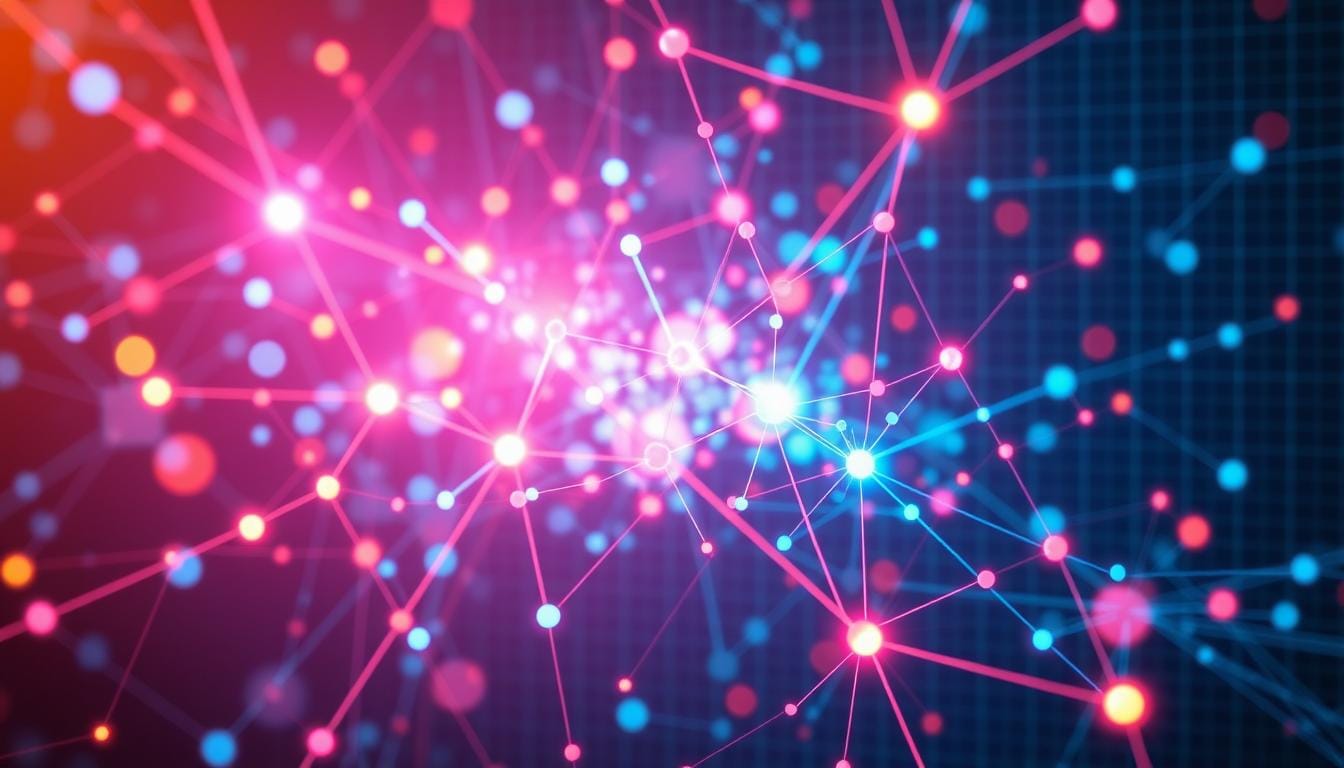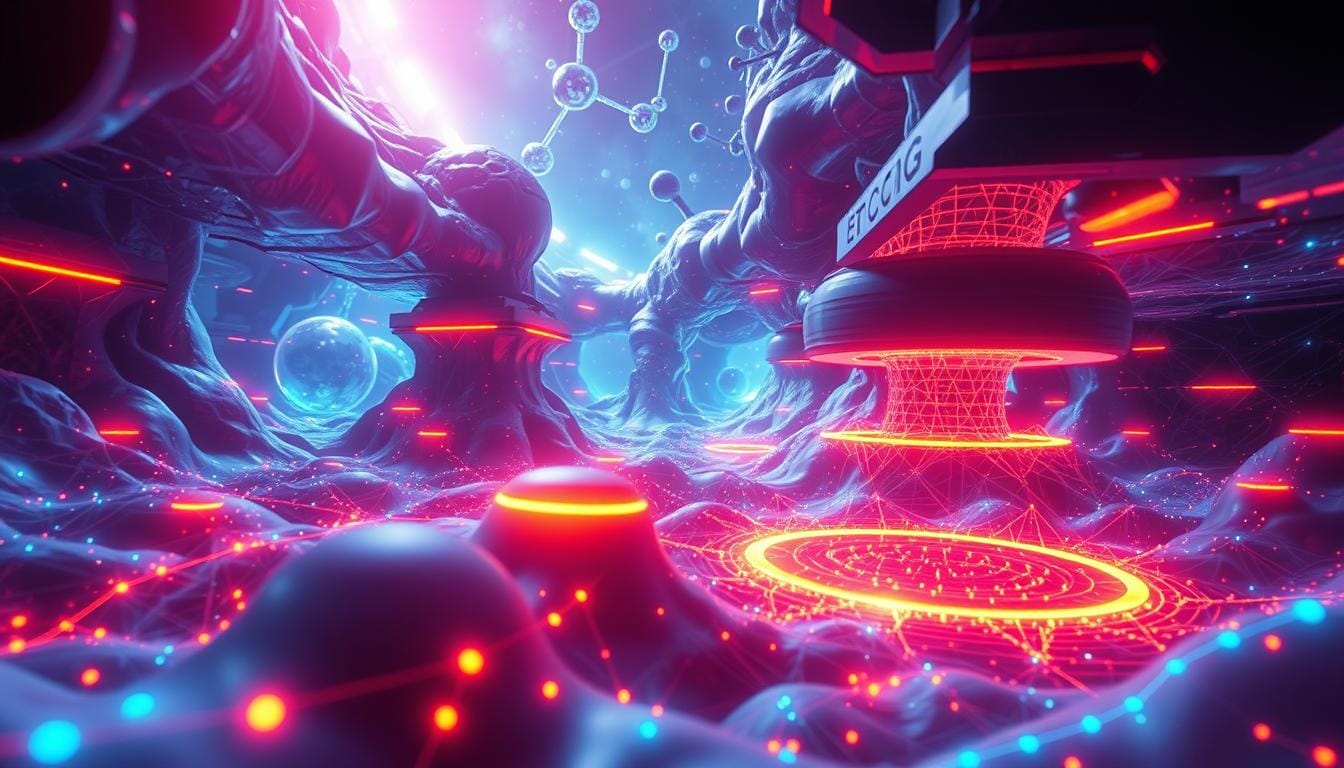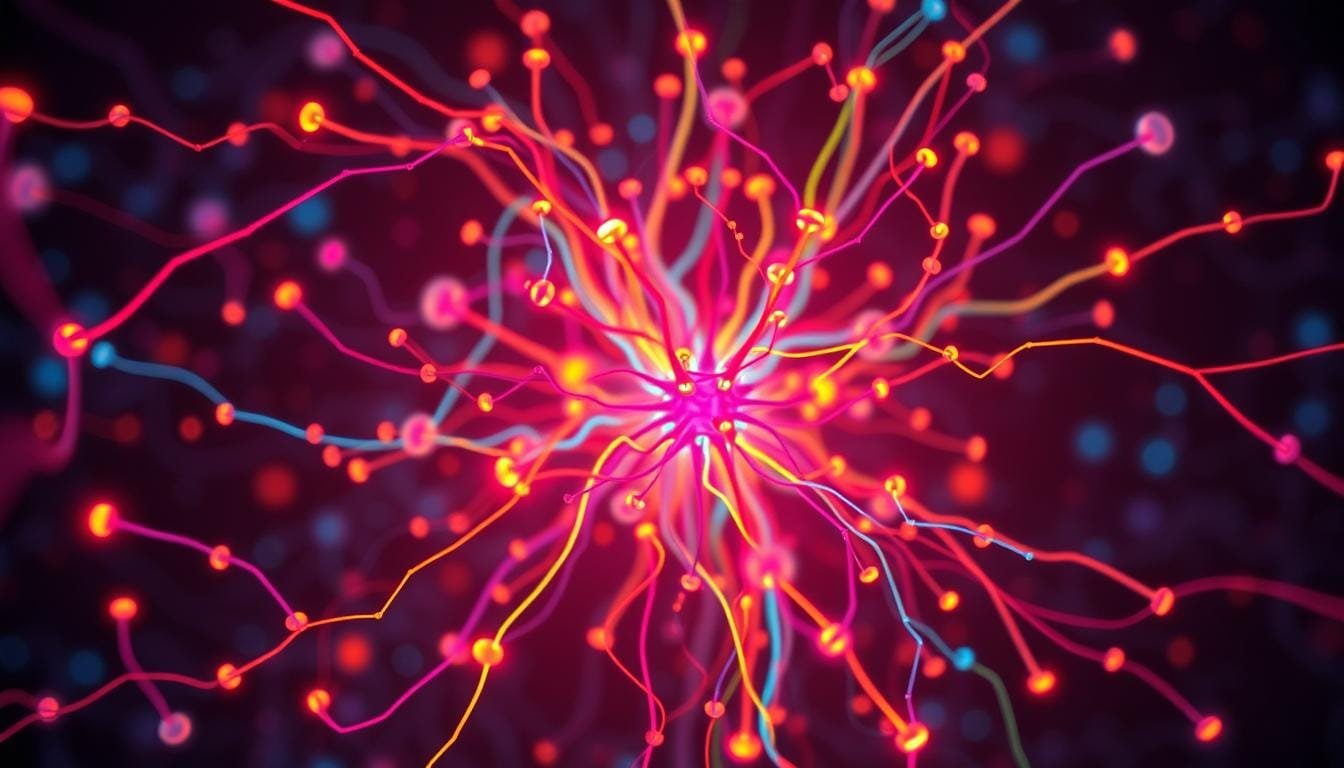Neural networks are key in artificial intelligence, inspired by the human brain. They help machines learn and make choices. These networks are used in many areas, like recognizing images and speech, understanding language, and in expert systems.
For those new to artificial intelligence, knowing about neural networks is vital. They are made up of layers of nodes or “neurons.” These nodes help machines learn, spot patterns, and make predictions or choices.
Introduction to Neural Networks and Artificial Intelligence
Studying neural networks has greatly improved artificial intelligence. By copying the brain’s structure, scientists have made advanced systems. For beginners, learning about neural networks is a first step into the world of AI.
Key Takeaways
- Neural networks are a crucial component of artificial intelligence
- Artificial neural network systems are inspired by the human brain’s structure and function
- Neural networks are designed to process and interpret complex data
- Understanding neural networks is essential for beginners interested in artificial intelligence
- Neural networks have various applications in fields like image and speech recognition, natural language processing, and expert systems
- Neural networks are composed of layers of interconnected nodes or “neurons” that process and transmit information
Understanding Neural Networks: The Building Blocks of AI
Neural networks are key to artificial intelligence, designed to work like the human brain. They have layers of nodes or “neurons” that handle and send information. This setup lets neural networks learn and get better over time, making them vital in AI.
Neural networks have input, hidden, and output layers. The input layer gets data, which is then worked on by the hidden layers. The output layer then shows what the network predicts. Algorithms and math help the network learn from the data it gets.
What Are Neural Networks?
Neural networks are inspired by the human brain and are a type of machine learning model. They can learn from data, spot patterns, and make predictions or choices. Thanks to neural networks, AI has become more advanced, allowing for complex tasks to be performed.
How Neural Networks Mirror Human Brain Function
Neural networks are made to work like the human brain by using artificial neurons. These neurons process and send information, just like our brain does when it learns and adapts. This has helped create AI models that can learn, reason, and decide, just like we do.
Basic Components and Structure
The basic parts of neural networks are:
- Input layers: receive data
- Hidden layers: process data
- Output layers: generate predicted outcomes
Knowing how neural networks work is key to making and using AI models. By using neural networks, we can build models that can do things like recognize images, understand language, and make decisions.
The Evolution of Artificial Neural Networks
Artificial neural networks have changed a lot since they started. Deep learning has made them better at finding patterns in data. This has led to big improvements in things like image and speech recognition.
The growth of neural networks is thanks to better computers, more data, and new neural networks and deep learning ideas. Key moments include:
- The first artificial neural network was introduced in the 1940s
- The backpropagation algorithm came out in the 1980s
- Graph neural network designs began in the 2010s
Now, neural networks play a big role in AI. They help in healthcare, finance, and transportation. As research keeps going, we’ll see even more cool uses of neural networks and deep learning.
How Neural Networks Process Information
Neural networks process information in layers. They start with the input layer, then move through hidden layers, and end at the output layer. This layered approach helps them learn and show complex data patterns. A convolutional neural network is great for handling images and signals.
The journey starts at the input layer, where the network gets the first data. This data then goes through hidden layers for complex processing. It’s in these layers that the network learns to understand the data in a deeper way. In neural network python code, these layers can be tailored for different tasks.
Input Layer Functionality
The input layer gets and processes the first data. This data can be images, text, or sounds. It’s designed to handle the specific data type.
Hidden Layer Processing
The hidden layers do the heavy lifting. They use both simple and complex changes to make the data meaningful. The number and type of hidden layers depend on the task and data complexity.
Output Layer Results
The output layer gives the final results. These can be labels, numbers, or probabilities. It’s designed to match the task’s needs.
Knowing how neural networks work helps developers create better architectures. They can use convolutional neural network and neural network python tools to do this.
Types of Neural Networks and Their Applications
Neural networks are key in artificial intelligence. They come in different types, each with its own strengths and uses. Graph neural networks are great for handling data that’s structured like graphs, like social networks or molecules.
Neural network machine learning sees graph neural networks as very promising. They excel in tasks like classifying nodes, predicting links, and classifying graphs. Here are some areas where they shine:
- Recommendation systems
- Natural language processing
- Computer vision
Other neural networks, like feedforward and recurrent ones, also have their own roles. They’re good for various tasks and uses. Knowing about these different networks helps developers and researchers pick the right one for their needs.

Deep Learning and Neural Networks: A Powerful Combination
Deep learning is a part of machine learning that uses neural networks to help machines learn from data. It has changed artificial intelligence a lot. Now, we see big improvements in image recognition, understanding language, and speech recognition. Neural networks are key to deep learning, as they help these algorithms work.
Artificial neural networks are like the human brain in learning and adapting. They are the base of deep learning. This lets developers make complex models that get better with more data.
Understanding Deep Learning
Deep learning uses neural networks with many layers to find complex patterns in data. This makes models very accurate for many tasks. Neural networks and deep learning are crucial for making and training these models.
The Role of Neural Networks in Deep Learning
Neural networks are vital in deep learning. They help build and train complex models. This way, developers can make models that learn from lots of data and get better over time. This has led to big steps forward in computer vision, language understanding, and speech recognition.
Popular Deep Learning Frameworks
There are many deep learning frameworks like TensorFlow, PyTorch, and Keras. These frameworks offer tools and libraries for making and using deep learning models. They help developers create models that learn from big datasets and get better with time. This uses the power of neural networks and deep learning.
Training Neural Networks: Methods and Best Practices
Training neural networks requires picking the right algorithms and preparing data well. You need to choose a good artificial neural network architecture and make it perform well. Developers use algorithms like backpropagation and stochastic gradient descent to reduce errors and boost accuracy.
Getting the data ready is also key. This means collecting and cleaning the data, dealing with missing values, and dividing it into training and testing sets. By following best practices, like data normalization and regularization, you can avoid overfitting. This ensures your neural networks work well with new data.

Some important things to think about when training artificial neural networks include:
- Choosing the right optimization technique, such as Adam or RMSprop
- Monitoring network performance using metrics like accuracy and loss
- Regularly updating the network architecture to adapt to changing data distributions
By sticking to these methods and best practices, developers can create powerful neural networks. These networks can lead to big improvements in areas like image recognition and natural language processing.
Real-World Applications of Neural Network Technology
Neural networks are changing many industries, making our lives better. They help in healthcare, finance, and more. A convolutional neural network is great for recognizing images, like spotting diseases in scans.
In finance, graph neural networks predict market trends. They help investors make smart choices by analyzing complex data. Some main uses of neural networks are:
- Healthcare and medical diagnosis
- Financial market predictions
- Image and speech recognition
- Autonomous vehicles
These examples show how neural networks can change industries. As they keep getting better, we’ll see even more cool uses in the future.
Neural networks aren’t just for these areas. They can help in any field that needs to understand complex data. With convolutional neural network and graph neural network tech getting better, our lives will keep improving.
Common Challenges and Solutions in Neural Network Implementation
Working with neural networks can be tricky. Two big problems are overfitting and underfitting. Overfitting makes the network too good at training data but not new data. Underfitting makes it too simple, missing important data patterns.
To fix these, developers use techniques like regularization and dropout. Regularization adds a penalty to keep the network simple. Dropout randomly removes units to avoid overreliance. Early stopping stops training when performance drops.
Computational power and data quality are also big hurdles. Neural networks need lots of power and data to learn well. Cloud services like Google Colab or Amazon SageMaker help with resources. Data augmentation increases the training dataset’s size and variety.
- Regularization techniques, such as L1 and L2 regularization
- Dropout and early stopping to prevent overfitting
- Cloud-based services for scalable computational resources
- Data augmentation techniques to increase dataset size and diversity
By tackling these challenges, developers can make neural networks work better. This leads to more accurate results and better performance.
Getting Started with Neural Networks: Tools and Resources
To start exploring neural networks and deep learning, you need the right tools and resources. For those interested in graph neural networks, frameworks like TensorFlow and PyTorch are available.
Some key resources for beginners include:
- Online courses, such as those offered by Stanford University and MIT
- Books, like “Deep Learning” by Ian Goodfellow, Yoshua Bengio, and Aaron Courville
- Communities, such as Kaggle and Reddit’s Machine Learning forum
These resources give a solid start for understanding neural networks and deep learning, including graph neural networks. With these tools and resources, beginners can start building their own projects. They can also experiment with neural networks and deep learning techniques.
Conclusion: The Future of Neural Networks in AI Development
Neural networks are key to modern artificial intelligence. They learn and adapt like our brains, leading to big leaps in healthcare, finance, and more. But, the journey of neural networks in AI is just starting.
The future of neural networks looks bright. Researchers are working hard to make networks better and more efficient. New hardware, like special chips and quantum computers, will help them do even more.
Neural networks will keep changing AI for the better. They’ll help us see and understand better, and even create smart virtual helpers. As we learn more about our brains, neural networks will keep changing the world.
